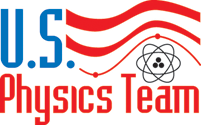United States National Physics Olympiad
United States National Physics Olympiad
The United States National Physics Olympiad (USAPhO) is a high school physics competition run by the American Association of Physics Teachers and American Institute of Physics to select the team to represent United States at the International Physics Olympiad (IPhO). The team is selected through a series of exams testing their problem solving abilities. Approximately the top 20 finalists are invited to a rigorous study camp at University of Maryland to prepare for the IPhO.

US Physics Team Logo
History
The International Physics Olympiad began in 1967 among Eastern European countries and many western countries soon joined in the 1970s. In 1986, Jack Wilson, AAPT Executive Officer, the American Association of Physics Teachers organized the United States Physics Team for the first time.
The 1986 team was made up of 20 talented high school physics students who had been nominated by their teachers. Five students were selected for the International Physics Olympiad after a rigorous preparation by University of Maryland. At the 1986 London IPhO, the team brought home three bronze medals.
Since then, the US Physics Team has been very successful at the International competition, usually placing in the top ten nations. It has accumulated 52 Gold Medals, 37 Silver Medals, 29 Bronze Medals, and 11 Honorable Mentions at IPhO as of 2014.
Academic Directors
- JiaJia Dong (2018–present)
- Paul Stanley (2008-2018)
- Robert Shurtz (2006-2008)
- Mary Mogee (1998-2005)
- Ed Neuenschwander (1996-1998)
- Larry Kirkpatrick (1988-1995)
Physics Team Selection
The current procedure to select the U.S. Physics Team consists of two exams, the preliminary "F=ma" Exam and the final "USA Physics Olympiad Exam" (USAPhO). After that, approximately the top 20 finishers are invited to join the U.S. Physics Team at the training camp. In previous years, there have been free response questions on the preliminary round as well as a quarterfinal round in between the preliminary and semifinal. As of 2017, there are only two rounds of testing.
Preliminary Exam
This exam is known as the F = ma contest. There are 25 multiple choice questions in 75 minutes focusing only on non-calculus mechanics. In the past, one point was awarded for each correct answer and a quarter point penalty deducted for each incorrect answer. Using this scoring mechanism, the cut-off was 15.5 in 2012, 12.25 in 2013, and 12.5 in 2014. From 2015 onwards, no points are deducted for incorrect answers. The 2015, 2016, and 2017 cutoffs were 18, 14, and 16 respectively. Prior to 2018 the exam was offered over multiple weeks at the discretion of the exam centers. In 2018 the exam was changed to two single day events with two different F = ma exams, Test A and Test B. In 2018, the cutoff for A and B were 14 and 15 respectively. In 2019, the cutoff for test A and B were 16 and 17 respectively.
USAPhO Exam
Approximately the top 400 students from the preliminary exam will be invited to take this free response, calculus-based exam covering all topics in introductory physics: Mechanics, Electricity and Magnetism, Thermodynamics, Fluids, Relativity, Waves, and Nuclear and Atomic Physics. There are two parts in the exam. Part A has 4 problems to do in 90 minutes. Part B has 2 problems to do in 90 minutes. However, in 2018, Part A and Part B each had 3 problems to do in 90 minutes. Prior to 2017 the exam could be taken at any time during a two-week window in March. In 2017 the exam was moved to be a single day event in early April.
Training Camp
The top ~20 finalists in the nation based off the scores of the above exams are invited to a rigorous training camp at the University of Maryland. There students receive heavy theoretical and experimental training and take a series of tests. Finally, the top five students are selected to participate in the International Physics Olympiad.
Recognition
All semifinalists receive certificates as a reward for their physics skill. Since 2013, medal rankings have also been awarded for the top scores on the Semifinal exam. Gold is about top 10%, Silver is about top 25%, Bronze is about top 40% and Honorable Mention is about top 60%.
Reception
The Physics Olympiad has been well received by many teachers and students who are attempting to promote and nurture interests in the increasingly demanding field of physics.


